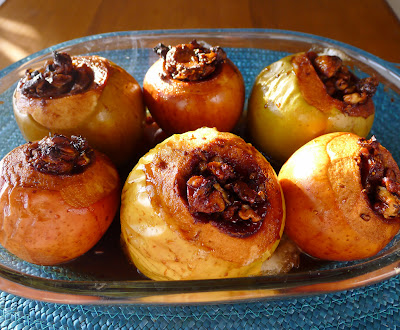 |
| Juicy slices of Ibérico pork, larded with herbs and spices. |
Lars teaches about charcuterie at the CIA, so he was interested in visiting a producer of Ibérico pork. Ann took us to the guy where she buys her Ibérico ham, Miguel Merino Ruiz of Ibéricos Yunquera https://sites.google.com/site/ibericosmerino. Miguel produces Ibérico ham, sausages and fresh pork from his own pigs.
 |
| Miguel Merino shows us a loin of Ibérico pork. |
The pigs that Miguel Merino raises are Ibérico breed—but not finished on bellotas, acorns, which distinguishes the very finest Ibérico hams. These pigs are grain-fed. But, because they are Ibérico breed, they still have the intense marbling that makes the meat so fabulous.
 |
| The pluma, from the side of the loin. |
Fresh Ibérico pork meat comes in a variety of cuts with curious names like secreto, pluma, presa—“secret,” “feather” and “prize”. Miguel, the pork butcher, also makes Ibérico sausages and some vacuum-packed ready-to-serve meats such as cerdo mechado, a herb-inflected pot roast of pork shoulder that can be served hot or cold.
I bought a hunk of fresh Ibérico pork shoulder to cook at home, using an Andalusian recipe for carne mechado. I also bought some pluma—a thin cut from the side of the loin, perfect for the grill—to stash in the freezer.
 |
| Pork shoulder, marbled with fat. |
 |
| Grilled pluma, or "feather." |
Carne de Cerdo Mechado
Larded Pork Pot Roast
Mechar means to “lard” a piece of meat. In the French manner, a larding needle is used to thread a piece of fat through a cut of meat. The fat helps keep the meat juicy while cooking. In the Spanish home kitchen, I watched village cooks “lard” a pot roast by cutting slits in the meat and inserting strips of salt pork with spices and herbs.
If using Ibérico pork, the natural marbling provides the juiciness. Instead, the pot roast is “larded” with flavor—garlic, spices and herbs. If you are not using Ibérico pork, you may wish to use strips of salt pork to lard the meat, so it stays juicy as it cooks.
Use a boneless blade roast, Boston butt or picnic ham in this recipe. Shoulder roasts have a lot of connective tissue that cooks up tender with slow cooking.
 |
| Slices of pork with sauce. |
2 pounds boneless shoulder pork roast
1 clove
10 peppercorns
1 teaspoon coarse salt
3 cloves garlic
2 tablespoons chopped parsley
Sprigs of fresh thyme
2 teaspoons olive oil
Strips of salt pork (optional)
2 tablespoons olive oil or pork lard
½ cup Sherry or white wine
¾ cup stock or water
2 tomatoes, quartered
1 onion, quartered
4 carrots, halved
1 head garlic, char-roasted (see below)
1 bay leaf
Salt and pepper
In a mortar, crush the clove and peppercorns. Add the salt, garlic, parsley and a few thyme leaves. Crush to a paste. Mix with 2 teaspoons oil.
With a sharp knife cut deep gashes into the piece of meat. Use the knife blade or fingers to push some of the paste into the slits. If using, plug the slits with strips of salt pork. Continue, spacing the gashes regularly on the meat’s surface. Tie the meat with twine, giving it a good shape.
Heat the oil or lard in a pan big enough to hold the piece of meat. Brown the meat, very slowly, on all sides. Add the onion, carrot, tomatoes, and roasted garlic cloves. Put in the bay leaf, a sprig of thyme, Sherry and stock. Cook the meat very slowly until fork-tender, about 1 ½ hours.
Remove the meat to a cutting board. Discard the string, and slice the meat. Sieve the sauce, pressing on the solids, and spoon the sauce over the meat.
 |
| Char-roasted head of garlic. |
 |
| Pork pot roast with vegetables. |














